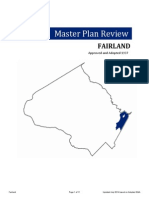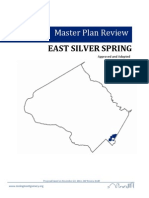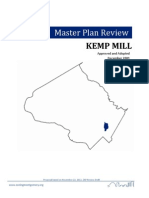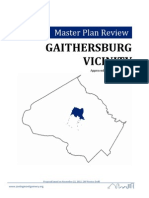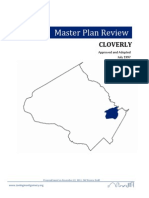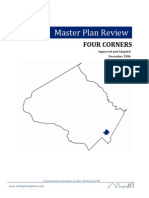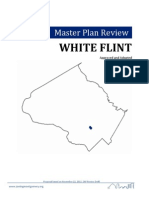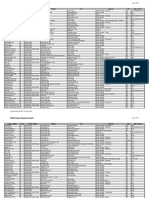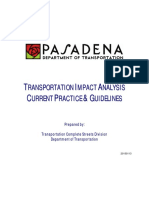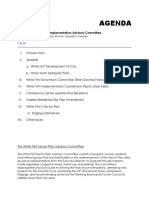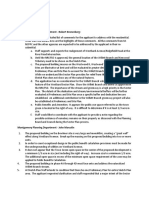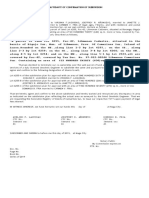0 ratings0% found this document useful (0 votes)
132 viewsMaster Plan Review: Aspen Hill
Master Plan Review: Aspen Hill
Uploaded by
Planning DocsThe document summarizes the zoning code rewrite process for Montgomery County, Maryland. It overviews the rewrite of the county's 1,200+ page zoning code, last updated in 1977, to simplify zones, eliminate redundancy, and clarify development standards. It discusses translating the county's 123 existing zones into around 30 proposed zones, either directly or by combining similar zones. For the Aspen Hill planning area specifically, it outlines how the 25 existing zones will translate to the new code, including keeping many residential zones the same and combining some commercial and mixed-use zones using master plan recommendations and standard translation criteria.
Copyright:
© All Rights Reserved
Available Formats
Download as PDF, TXT or read online from Scribd
Master Plan Review: Aspen Hill
Master Plan Review: Aspen Hill
Uploaded by
Planning Docs0 ratings0% found this document useful (0 votes)
132 views13 pagesThe document summarizes the zoning code rewrite process for Montgomery County, Maryland. It overviews the rewrite of the county's 1,200+ page zoning code, last updated in 1977, to simplify zones, eliminate redundancy, and clarify development standards. It discusses translating the county's 123 existing zones into around 30 proposed zones, either directly or by combining similar zones. For the Aspen Hill planning area specifically, it outlines how the 25 existing zones will translate to the new code, including keeping many residential zones the same and combining some commercial and mixed-use zones using master plan recommendations and standard translation criteria.
Original Title
Untitled
Copyright
© © All Rights Reserved
Available Formats
PDF, TXT or read online from Scribd
Share this document
Did you find this document useful?
Is this content inappropriate?
The document summarizes the zoning code rewrite process for Montgomery County, Maryland. It overviews the rewrite of the county's 1,200+ page zoning code, last updated in 1977, to simplify zones, eliminate redundancy, and clarify development standards. It discusses translating the county's 123 existing zones into around 30 proposed zones, either directly or by combining similar zones. For the Aspen Hill planning area specifically, it outlines how the 25 existing zones will translate to the new code, including keeping many residential zones the same and combining some commercial and mixed-use zones using master plan recommendations and standard translation criteria.
Copyright:
© All Rights Reserved
Available Formats
Download as PDF, TXT or read online from Scribd
Download as pdf or txt
0 ratings0% found this document useful (0 votes)
132 views13 pagesMaster Plan Review: Aspen Hill
Master Plan Review: Aspen Hill
Uploaded by
Planning DocsThe document summarizes the zoning code rewrite process for Montgomery County, Maryland. It overviews the rewrite of the county's 1,200+ page zoning code, last updated in 1977, to simplify zones, eliminate redundancy, and clarify development standards. It discusses translating the county's 123 existing zones into around 30 proposed zones, either directly or by combining similar zones. For the Aspen Hill planning area specifically, it outlines how the 25 existing zones will translate to the new code, including keeping many residential zones the same and combining some commercial and mixed-use zones using master plan recommendations and standard translation criteria.
Copyright:
© All Rights Reserved
Available Formats
Download as PDF, TXT or read online from Scribd
Download as pdf or txt
You are on page 1of 13
Master Plan Review
Approved and Adopted
April 2004
ASPEN HILL
Aspen Hill Page 1 of 13 Updated July 2014 based on Adopted DMA
Public Listening Session 9/2009
ONING CODE REWRITE
In 2007, the Montgomery County Council directed the Planning Department to undertake a
comprehensive zoning ordinance rewrite. Last rewritten in 1977, the current 1,200
+
page code is
viewed as antiquated and hard to use with standards that have failed to keep pace with modern
development practices.
With only about four percent of land in the County available for greenfield development, the new
zoning code can play a crucial role in guiding redevelopment to areas like surface parking lots and
strip shopping centers. An updated zoning code is important for achieving the kind of growth
Montgomery County policymakers and residents want.
Initial sections of the new code were drafted by Code
Studio, a zoning consultant. These drafts were
subsequently analyzed and edited by planners based
on feedback from the Zoning Advisory Panel (a citizen
panel appointed by the Planning Board to weigh in on
the projects direction), county agency representatives,
residents and other stakeholders. In September 2012,
planning staff began the release of a draft code in
sections accompanied by a report highlighting changes
from the current code. The staff drafts were reviewed
at length by the Planning Board.
The Planning Board held worksessions and public hearings between September of 2012 and May of
2013. On May 2, they transmitted their draft to the County Council. The Council adopted the text of
the new code in March and adopted the new zoning map in July 2014.
The new code and map will go into effect on October 30, 2014.
ZONE IMPLEMENTATION PROCESS
An important aspect of the Zoning Rewrite process is the potential simplification of 123 existing
zones into about 30 proposed zones. While some of the proposed zones are a direct one-to-one
translation of existing zones, others are the result of combining existing zones with similar
standards. Additionally, existing zones that are not currently mapped or are no longer used in the
County have been eliminated from the proposed code. Through the implementation process,
Montgomery County aims to simplify the number of zones, eliminate redundancy, and clarify
development standards. A full translation table for all zones can be found in the documents section
of our website: www.zoningmontgomery.org.
BACKGROUND
Aspen Hill Page 2 of 13 Updated July 2014 based on Adopted DMA
Agricultural, Residential, and Industrial Zone Implementation:
For agricultural and rural zones, the existing zones will be translated to proposed zones on a one-to-
one basis, with the exception of the Low Density Rural Cluster zone which is not currently used in
the County and will be eliminated.
Many of the existing residential zones will remain the same. Other residential zones will be
combined with existing zones that have similar development standards. The R-4Plex zone, which is
not currently mapped anywhere in the county, will be removed from the proposed code.
Implementation of Industrial zones will combine similar zones (Rural Service, I-1, and R+D) into the
proposed Industrial Moderate (IM) zone. The existing heavy industrial zone (I-2) will be renamed as
the Industrial Heavy (IH) zone.
Examples:
Agricultural
and Rural
Rural Density
Transfer (RDT)
Agricultural
Reserve (AR)
R-60
(detached residential)
R-60
(detached residential)
R-60/TDR
(detached residential)
Residential
Aspen Hill Page 3 of 13 Updated July 2014 based on Adopted DMA
Commercial and Mixed-Use Zone Implementation:
Parcels located in the existing Commercial, Mixed-use, Central Business District (CBD), and Transit
Station zones will be translated into one of the proposed Commercial/Residential (CR) or
Employment (E) Zones using a two-tiered process.
First, decisions about specific parcels in these zones were based on recommendations within the
Master Plan. Planning staff reviewed each Master Plan in the County. When the Master Plan
provided specific recommendations about allowed density, height, or mix of uses for individual
commercial or mixed-use parcels, those recommendations were used to build the formula of the
proposed zone. This ensures consistency with currently allowed density and height, and helps
codify Master Plan recommendations in a parcel-specific manner.
Second, if the Master Plan did not make specific recommendations, the current zone changed to a
proposed zone on a one-to-one basis or the proposed zone was determined using a specific
standardized decision tree (see example below). The standardized decision tree translates existing
zones by considering each specific parcels proximity to single-family neighborhoods or other
factors. The goal of the implementation decision tree is to retain currently allowed heights and
densities and maintain context sensitivity.
Example: C-1 Convenience Commercial
Confronts or abuts
R-150 or less intense
or site is bigger than 5 acres
NR-0.75
H-45
then
Within a Historic
District
NR-0.75
H-45
then
Confronts or abuts
R-90, R-60, R-40, or R-MH
CRT-0.75
C-0.75 R-0.25 H-35
then
Confronts or abuts RT
or more intense
CRT-0.75
C-0.75 R-0.25 H-45
then
C-1
if
Aspen Hill Page 4 of 13 Updated July 2014 based on Adopted DMA
PLAN HIGHLIGHTS
The Aspen Hill Master Plan was approved and adopted in April 2004. The Master Plan reinforces the
primarily suburban and residential character of Aspen Hill, seeks to increase opportunities for
community interaction, and promotes diverse recreation and transportation options for community
residents and workers.
To support its vision for Aspen Hill, the Master Plan makes key recommendations for each of the five
areas: Land Use, Transportation, Environment, and Historic Resources and Facilities. In the area of Land
Use, the Master Plan recommends returning the former Vitro site to office use in the long term,
continuing the existing office use of the Lee Development Group site, transforming the right-of-way for
the former Rockville Facility to green space, and permitting appropriate infill development.
The Plans transportation element recommends creating a multi-use trail system to function as a
recreational and commuting resource, promoting a hiker-biker connection from Rock Creek Park to
Northwest Branch Park, and providing incentives to reduce vehicular trips. The Master Plan also
provides environmental recommendations that advocate for protecting stream valleys, wetlands, and
forested areas through development regulations; implementing stormwater management retrofits of
developed sites; and expanding
recycling programs for multi-family and
non-residential developments.
In the areas of Historic Resources and
Facilities, the Master Plan promotes
preserving the communitys historic and
architectural resources. The Plan also
recommends providing adequate
funding for the upkeep of recreational
facilities, allowing child day care
facilities in the non-age restricted
portion of the PRC zone, and supporting
a separate zip code for Aspen Hill to
increase community identity.
ASPEN HILL
Aspen Hills National Capital Trolley
Museum
Aspen Hill Page 5 of 13 Updated July 2014 based on Adopted DMA
The Aspen Hill Planning Area currently has 25 zones: 15 Residential, 1 Mixed-Use, 5 Commercial, and 4
Planned Development.
Existing Residential:
RE-1: Detached Unit, Single-Family
RE-1/TDR: Detached Unit, Single-Family
RE-2: Detached Unit, Single-Family
RE-2/TDR: Detached Unit, Single-Family
R-150/TDR: Detached Unit, Single-
Family
R-150: Detached Unit, Single-Family
R-200: Detached Unit, Single-Family
R-60: Detached Unit, Single-Family
R-60/TDR: Detached Unit, Single-Family
R-90: Detached Unit, Single-Family
RT-8: Townhouse, Single-Family
RT-12.5: Townhouse, Single-Family
R-20: Multi-Family, Medium Density
R-30: Multi-Family, Low Density
R-H: Multi-Family, High-Rise Planned
Existing Commercial
C-1: Convenience Commercial
C-2: General Commercial
C-O: Commercial, Office Building
C-T: Commercial, Transitional
O-M: Office Building, Moderate
Intensity
Existing Mixed-Use:
RMX-2C: Residential Mixed Use
Existing Planned Development
PD-2: Planned Development
PD-3: Planned Development
PD-7: Planned Development
PRC: Planned Retirement Community
Standard Implementation:
The existing RE-1 and RE-1/TDR will translate to the proposed RE-1 zone. The existing RE-2 and RE-2/TDR
will translate to the proposed RE-2 zone. The existing R-150, R-150/TDR, and R-200 zones will be
combined to form the proposed R-200 zone. The existing R-60 and R-60/TDR will translate to the
proposed R-60 zone. The existing R-90 will remain R-90. All existing TDR zones will have a new TDR
Overlay zone.
The existing RT-8 will remain RT-8 (Townhouse) zone and the existing RT-12.5 will remain RT-12.5
(Townhouse) zone. The R-20, R-30, and R-H will remain.
The existing Planned Development PD-2, PD-3, and PD-7 zones will remain.The PRC zone will remain
PRC.
The existing Commercial and Mixed-Use zones will translate to the specific proposed EOF (Employment
Office), NR (Neighborhood Retail), CRN (Commercial Residential), and CRT (Commercial Residential
Town) zones using both the standard translation criteria and specific Master Plan recommendations.
Commercial and Mixed-Use parcels that do not have specific Master Plan recommendations will
translate to the proposed zone based on the standard zoning translation table.
ZONE IMPLEMENTATION
Aspen Hill Page 6 of 13 Updated July 2014 based on Adopted DMA
In some cases, properties were not converted using the standard conversions as outlined earlier in the
packet.
Generally, this is because the relevant Master or Sector Plan made recommendations regarding the
appropriate density, height, or mix of uses on a given site.
In other cases, the text of the zoning ordinance or an overlay zone can affect the development potential
of a site, and therefore affect the conversion given as part of the draft proposed DMA.
Additionally, the PHED Committee instructed that, when requested by a property owner, existing site
approvals be reflected in the draft proposed DMA. Non-standard conversions sometimes reflect these
project approvals.
The following pages will give detail on all of the non-standard conversions in this plan area.
NON-STANDARD CONVERSIONS
Aspen Hill Page 7 of 13 Updated July 2014 based on Adopted DMA
MP Number: ASPEN-02
Master Plan: Aspen Hill
Location: Connecticut Ave & Aspen Hill Rd
Existing Zone: C-O
Standard Conv: EOF-3.0 H-100
Proposed Conv: EOF-3.0 H-60
M
o
d
i
f
i
c
a
t
i
o
n
s
Zone Group: No change
Overall FAR: No change
Comml FAR: -
Residl FAR: -
Height: Reduced to 60
Reason for non-standard conversion:
Aspen Hill Master Plan: Page 46-47
No structure, excluding building mechanics, should be higher
than two stories above the existing structure [which is 3 stories
in height].
Aspen Hill Page 8 of 13 Updated July 2014 based on Adopted DMA
Aspen Hill
Existing Proposed
Zone Acres Percent Zone Acres Percent
RE-1 30.63 0.42
RE-1 45.95 0.61
RE-1/TDR 15.32 0.21
RE-2 952.54 13.18
RE-2 1,002.81 13.88
RE-2/TDR 50.27 0.70
R-150 193.52 2.68
R-200 2,750.62 38.05 R-150/TDR 12.04 0.17
R-200 2,545.06 35.20
R-60 634.32 8.77
R-60 635.49 8.79
R-60/TDR 1.17 0.02
R-90 1,338.02 18.51 R-90 1338.02 18.51
RT-8 5.27 0.07 RT-8 5.27 0.07
RT-12.5 36.51 0.51 RT-12.5 36.51 0.51
R-20 238.21 3.29 R-20 238.21 3.29
R-30 33.14 0.46 R-30 33.14 0.46
R-H 19.84 0.27 R-H 19.84 0.27
RMX-2C 13.21 0.18 CRT-2.0 C-0.5 R-1.5 H-65 T 13.21 0.18
C-1 66.11 0.91
CRT-0.75 C-0.75 R-0.25 H-35 1.08
0.01
CRT-0.75 C-0.75 R-0.25 H-45 2.89 0.04
NR-0.75 H-45 62.14 0.86
C-2 19.17 0.27
CRT-2.25 C-1.5 R-0.75 H-45 2.89 0.04
CRT-2.25 C-1.5 R-0.75 H-75 16.28 0.23
C-O 5.13 0.07 EOF-3.0 H-60 5.13 0.07
C-T 1.79 0.02 CRN-0.5 C-0.5 R-0.25 H-35 1.79 0.02
O-M 2.06 0.03
EOF-1.5 H-60 0.88 0.01
EOF-1.5 H-75 1.18 0.02
PD-2 14.28 0.20 PD-2 14.28 0.20
PD-3 26.70 0.37 PD-3 26.70 0.37
PD-7 28.09 0.39 PD-7 28.09 0.39
PRC 947.17 13.10 PRC 947.17 13.10
Grand Total 7,229.57 Grand Total 7,229.57
ZONE IMPLEMENTATION
Aspen Hill Page 9 of 13 Updated July 2014 based on Adopted DMA
Aspen Hill: Existing Zoning
Residential Estate
Residental Low Density
Residential Medium Density
Townhouse
Multi-Family
Mixed-Use
Commercial
Planned Development
Aspen Hill: Proposed Zoning
Residential Estate
Residental Low Density
Residential Medium Density
Townhouse
Multi-Family
Comm/Res - Neighborhood
Comm/Res - Town
Neighborhood Retail
Employment, Office
Planned Development
ZONE IMPLEMENTATION
Aspen Hill Page 10 of 13 Updated July 2014 based on Adopted DMA
RE-1
RE-1/TDR
RE-2
RE-2/TDR
R-150
R-200
R-200/TDR
R-60
R-60/TDR
R-90
Townhouse
RT-8
RT-12.5
Multi-Family
R-H
R-20
R-30
Commercial
C-1
C-2
C-T
C-O
O-M
Mixed-Use
RMX-2C
PD-2
PD-3
PD-7
PRC
Existing Zones
Residential
Estate
Planned
Development
Residential Low
Density
Residential
Medium Density
EXISTING ZONING MAP
Aspen Hill Page 11 of 13 Updated July 2014 based on Adopted DMA
RE-1
RE-2
R-200
R-60
R-90
Townhouse
RT-8
RT-12.5
Multi-Family
R-H
R-20
R-30
CRN
CRT
NR
EOF
PD-2
PD-3
PD-7
PRC
Proposed Zones
Residential
Estate
Comm/Res-
Town
Employment,
Office
Residential Low
Density
Residential
Medium Density
Comm/Res-
Neighborhood
Neighborhood
Retail
Planned
Development
PROPOSED ZONING MAP
Aspen Hill Page 12 of 13 Updated July 2014 based on Adopted DMA
PLANNING AREA CONTEXT
Aspen Hill Page 13 of 13 Updated July 2014 based on Adopted DMA
You might also like
- List of Proclaimed Protected Areas in Region 8Document4 pagesList of Proclaimed Protected Areas in Region 8Kerwin Leonida100% (4)
- Master Plan Review: FairlandDocument11 pagesMaster Plan Review: FairlandPlanning DocsNo ratings yet
- Silver Spring East: Master Plan ReviewDocument11 pagesSilver Spring East: Master Plan ReviewPlanning DocsNo ratings yet
- Master Plan Review: North & West Silver SpringDocument11 pagesMaster Plan Review: North & West Silver SpringPlanning DocsNo ratings yet
- Master Plan Review: DamascusDocument19 pagesMaster Plan Review: DamascusPlanning DocsNo ratings yet
- Master Plan Review: Kemp MillDocument10 pagesMaster Plan Review: Kemp MillPlanning DocsNo ratings yet
- Master Plan Review: Aspen HillDocument13 pagesMaster Plan Review: Aspen HillPlanning DocsNo ratings yet
- Master Plan Review: WestbardDocument15 pagesMaster Plan Review: WestbardPlanning DocsNo ratings yet
- Upper Rock Creek: Master Plan ReviewDocument13 pagesUpper Rock Creek: Master Plan ReviewPlanning DocsNo ratings yet
- Master Plan Review: Sandy Spring - AshtonDocument16 pagesMaster Plan Review: Sandy Spring - AshtonPlanning DocsNo ratings yet
- Master Plan Review: Clarksburg & Hyattstown Special Study AreaDocument17 pagesMaster Plan Review: Clarksburg & Hyattstown Special Study AreaPlanning DocsNo ratings yet
- Master Plan Review: Silver Spring CBDDocument27 pagesMaster Plan Review: Silver Spring CBDPlanning DocsNo ratings yet
- Master Plan Review: CloverlyDocument11 pagesMaster Plan Review: CloverlyPlanning DocsNo ratings yet
- Master Plan Review: OlneyDocument11 pagesMaster Plan Review: OlneyPlanning DocsNo ratings yet
- Gaithersburg Vicinity: Master Plan ReviewDocument11 pagesGaithersburg Vicinity: Master Plan ReviewPlanning DocsNo ratings yet
- Master Plan Review: White OakDocument11 pagesMaster Plan Review: White OakPlanning DocsNo ratings yet
- Master Plan ReviewDocument15 pagesMaster Plan ReviewPlanning DocsNo ratings yet
- Master Plan Review: North & West Silver SpringDocument11 pagesMaster Plan Review: North & West Silver SpringPlanning DocsNo ratings yet
- Master Plan Review: Preservation of Agriculture & Rural Open SpaceDocument11 pagesMaster Plan Review: Preservation of Agriculture & Rural Open SpacePlanning DocsNo ratings yet
- East Silver Spring: Master Plan ReviewDocument11 pagesEast Silver Spring: Master Plan ReviewPlanning DocsNo ratings yet
- Master Plan Review: Long BranchDocument11 pagesMaster Plan Review: Long BranchPlanning DocsNo ratings yet
- Master Plan Review: Bethesda - Chevy ChaseDocument13 pagesMaster Plan Review: Bethesda - Chevy ChasePlanning DocsNo ratings yet
- Master Plan Review: FairlandDocument11 pagesMaster Plan Review: FairlandPlanning DocsNo ratings yet
- Master Plan Review: GlenmontDocument11 pagesMaster Plan Review: GlenmontPlanning DocsNo ratings yet
- Master Plan Review: Kensington - WheatonDocument11 pagesMaster Plan Review: Kensington - WheatonPlanning DocsNo ratings yet
- Master Plan Review: Forest GlenDocument10 pagesMaster Plan Review: Forest GlenPlanning DocsNo ratings yet
- Master Plan Review: DamascusDocument16 pagesMaster Plan Review: DamascusPlanning DocsNo ratings yet
- Master Plan Review: Shady GroveDocument26 pagesMaster Plan Review: Shady GrovePlanning DocsNo ratings yet
- Master Plan Review: Silver Spring CBDDocument20 pagesMaster Plan Review: Silver Spring CBDPlanning DocsNo ratings yet
- Master Plan Review: White FlintDocument16 pagesMaster Plan Review: White FlintPlanning DocsNo ratings yet
- Burtonsville Crossroads: Master Plan ReviewDocument13 pagesBurtonsville Crossroads: Master Plan ReviewPlanning DocsNo ratings yet
- Master Plan Review: WheatonDocument13 pagesMaster Plan Review: WheatonPlanning DocsNo ratings yet
- Master Plan Review: Shady GroveDocument18 pagesMaster Plan Review: Shady GrovePlanning DocsNo ratings yet
- Master Plan Review: Sandy Spring - AshtonDocument15 pagesMaster Plan Review: Sandy Spring - AshtonPlanning DocsNo ratings yet
- Master Plan Review: Takoma LangleyDocument11 pagesMaster Plan Review: Takoma LangleyPlanning DocsNo ratings yet
- Master Plan Review: OlneyDocument11 pagesMaster Plan Review: OlneyPlanning DocsNo ratings yet
- Master Plan Review: Kemp MillDocument10 pagesMaster Plan Review: Kemp MillPlanning DocsNo ratings yet
- Master Plan Review: Bethesda Purple Line StationDocument11 pagesMaster Plan Review: Bethesda Purple Line StationPlanning DocsNo ratings yet
- Master Plan Review: Clarksburg & Hyattstown Special Study AreaDocument15 pagesMaster Plan Review: Clarksburg & Hyattstown Special Study AreaPlanning DocsNo ratings yet
- Master Plan Review: Bethesda CBDDocument27 pagesMaster Plan Review: Bethesda CBDPlanning DocsNo ratings yet
- Upper Rock Creek: Master Plan ReviewDocument11 pagesUpper Rock Creek: Master Plan ReviewPlanning DocsNo ratings yet
- Master Plan Review: Forest GlenDocument10 pagesMaster Plan Review: Forest GlenPlanning DocsNo ratings yet
- Gaithersburg Vicinity: Master Plan ReviewDocument11 pagesGaithersburg Vicinity: Master Plan ReviewPlanning DocsNo ratings yet
- Master Plan Review: KensingtonDocument11 pagesMaster Plan Review: KensingtonPlanning DocsNo ratings yet
- Master Plan Review: Kensington - WheatonDocument11 pagesMaster Plan Review: Kensington - WheatonPlanning DocsNo ratings yet
- Master Plan Review: WestbardDocument12 pagesMaster Plan Review: WestbardPlanning DocsNo ratings yet
- Master Plan Review: Friendship HeightsDocument18 pagesMaster Plan Review: Friendship HeightsPlanning DocsNo ratings yet
- Master Plan Review: CloverlyDocument11 pagesMaster Plan Review: CloverlyPlanning DocsNo ratings yet
- Master Plan Review: PotomacDocument19 pagesMaster Plan Review: PotomacPlanning DocsNo ratings yet
- Master Plan Review: Capitol View & VicinityDocument10 pagesMaster Plan Review: Capitol View & VicinityPlanning DocsNo ratings yet
- Master Plan Review: Four CornersDocument11 pagesMaster Plan Review: Four CornersPlanning DocsNo ratings yet
- Master Plan Review: Capitol View & VicinityDocument10 pagesMaster Plan Review: Capitol View & VicinityPlanning DocsNo ratings yet
- Master Plan Review: Woodmont TriangleDocument18 pagesMaster Plan Review: Woodmont TrianglePlanning DocsNo ratings yet
- Great Seneca Science Corridor: Master Plan ReviewDocument21 pagesGreat Seneca Science Corridor: Master Plan ReviewPlanning DocsNo ratings yet
- Master Plan ReviewDocument15 pagesMaster Plan ReviewPlanning DocsNo ratings yet
- Master Plan Review: White OakDocument11 pagesMaster Plan Review: White OakPlanning DocsNo ratings yet
- Master Plan Review: Friendship HeightsDocument17 pagesMaster Plan Review: Friendship HeightsPlanning DocsNo ratings yet
- Master Plan Review: White FlintDocument15 pagesMaster Plan Review: White FlintPlanning DocsNo ratings yet
- Chevy Chase Lake: Master Plan ReviewDocument13 pagesChevy Chase Lake: Master Plan ReviewPlanning DocsNo ratings yet
- Great Seneca Science Corridor: Master Plan ReviewDocument16 pagesGreat Seneca Science Corridor: Master Plan ReviewPlanning DocsNo ratings yet
- Reducing Disaster Risk by Managing Urban Land Use: Guidance Notes for PlannersFrom EverandReducing Disaster Risk by Managing Urban Land Use: Guidance Notes for PlannersNo ratings yet
- HPC WORKSESSION - 7:00 P.M. in Third Floor Conference Room HPC MEETING - 7:30 P.M. in MRO AuditoriumDocument2 pagesHPC WORKSESSION - 7:00 P.M. in Third Floor Conference Room HPC MEETING - 7:30 P.M. in MRO AuditoriumPlanning DocsNo ratings yet
- Development Review Committee Monday, October 3, 2016 9:30 A.MDocument1 pageDevelopment Review Committee Monday, October 3, 2016 9:30 A.MPlanning DocsNo ratings yet
- Label - Name Type Ftype - Name From - TO - Mplan RW MP - ClassDocument2 pagesLabel - Name Type Ftype - Name From - TO - Mplan RW MP - ClassPlanning DocsNo ratings yet
- T I A C P & GDocument28 pagesT I A C P & GPlanning DocsNo ratings yet
- Planning Board Draft September 14, 2016Document36 pagesPlanning Board Draft September 14, 2016Planning DocsNo ratings yet
- HPC WORKSESSION - 7:00 P.M. in Third Floor Conference Room HPC MEETING - 7:30 P.M. in MRO AuditoriumDocument2 pagesHPC WORKSESSION - 7:00 P.M. in Third Floor Conference Room HPC MEETING - 7:30 P.M. in MRO AuditoriumPlanning DocsNo ratings yet
- Orange: YellowDocument10 pagesOrange: YellowPlanning DocsNo ratings yet
- About ZTA 16-03: BACKGROUND: Planning Board RecommendationDocument1 pageAbout ZTA 16-03: BACKGROUND: Planning Board RecommendationPlanning DocsNo ratings yet
- Distinct Topics:: 1 - Preliminary Program of Requirements - NotesDocument6 pagesDistinct Topics:: 1 - Preliminary Program of Requirements - NotesPlanning DocsNo ratings yet
- UntitledDocument36 pagesUntitledPlanning DocsNo ratings yet
- Appendix G:: ParksDocument15 pagesAppendix G:: ParksPlanning DocsNo ratings yet
- Environment: Appendix FDocument41 pagesEnvironment: Appendix FPlanning DocsNo ratings yet
- Bicycle Master Plan Community Advisory Group Agenda Meeting #8 September 7, 2016 - 7:30 To 9:00 PM Montgomery County Planning DepartmentDocument1 pageBicycle Master Plan Community Advisory Group Agenda Meeting #8 September 7, 2016 - 7:30 To 9:00 PM Montgomery County Planning DepartmentPlanning DocsNo ratings yet
- Orange: YellowDocument10 pagesOrange: YellowPlanning DocsNo ratings yet
- Agenda: White Flint Sector Plan Implementation Advisory CommitteeDocument1 pageAgenda: White Flint Sector Plan Implementation Advisory CommitteePlanning DocsNo ratings yet
- Rental Housing Study: Financial Analysis and Swot FindingsDocument43 pagesRental Housing Study: Financial Analysis and Swot FindingsPlanning DocsNo ratings yet
- 2016 Subdivision Staging Policy: Planning Board Recommendation SummaryDocument33 pages2016 Subdivision Staging Policy: Planning Board Recommendation SummaryPlanning DocsNo ratings yet
- Rental Housing Study: Financial Analysis and Swot FindingsDocument43 pagesRental Housing Study: Financial Analysis and Swot FindingsPlanning DocsNo ratings yet
- Retail Planning Study: Appendix DDocument241 pagesRetail Planning Study: Appendix DPlanning DocsNo ratings yet
- Transportation: Appendix EDocument63 pagesTransportation: Appendix EPlanning DocsNo ratings yet
- Loop Trail: 15% Concept DesignDocument39 pagesLoop Trail: 15% Concept DesignPlanning DocsNo ratings yet
- HPC WORKSESSION - 7:00 P.M. in Third Floor Conference Room HPC MEETING - 7:30 P.M. in MRO AuditoriumDocument4 pagesHPC WORKSESSION - 7:00 P.M. in Third Floor Conference Room HPC MEETING - 7:30 P.M. in MRO AuditoriumPlanning DocsNo ratings yet
- Bethesda: Downtown PlanDocument65 pagesBethesda: Downtown PlanPlanning DocsNo ratings yet
- Montgomery Planning Department - Robert KronenbergDocument3 pagesMontgomery Planning Department - Robert KronenbergPlanning DocsNo ratings yet
- Development Review Committee Monday, September 19, 2016 9:30 A.MDocument1 pageDevelopment Review Committee Monday, September 19, 2016 9:30 A.MPlanning DocsNo ratings yet
- UntitledDocument2 pagesUntitledPlanning DocsNo ratings yet
- LEAD: John Marcolin: 320170010, Westwood Shopping Center Sketch Plan DRC Comments Summary Area Team 1Document12 pagesLEAD: John Marcolin: 320170010, Westwood Shopping Center Sketch Plan DRC Comments Summary Area Team 1Planning DocsNo ratings yet
- Vicinity Map: Owner/Applicant / Master DeveloperDocument7 pagesVicinity Map: Owner/Applicant / Master DeveloperPlanning DocsNo ratings yet
- Larimer County Options For Land DivisionDocument2 pagesLarimer County Options For Land Divisionapi-19975677No ratings yet
- Confirmation of Subdivision CANTORDocument4 pagesConfirmation of Subdivision CANTORجينوفا ماركوNo ratings yet
- Peraturan Zonasi: Peran Dalam Pemanfaatan Ruang Dan Pembangunan Kembali Di Kawasan Rawan Bencana Kasus: Arkadelphia City, Arkansas USADocument10 pagesPeraturan Zonasi: Peran Dalam Pemanfaatan Ruang Dan Pembangunan Kembali Di Kawasan Rawan Bencana Kasus: Arkadelphia City, Arkansas USAcorry 'ainaNo ratings yet
- Splitting of Title BorresDocument8 pagesSplitting of Title Borresartemio villasNo ratings yet
- De-Annexation Petition MapDocument1 pageDe-Annexation Petition MapinforumdocsNo ratings yet
- Dominion LsDocument42 pagesDominion LsFredNo ratings yet
- Attachment B To S1 Land Use Zoning Amendments 09-01-16Document33 pagesAttachment B To S1 Land Use Zoning Amendments 09-01-16The UrbanistNo ratings yet
- Urban Open SpacesDocument5 pagesUrban Open SpacesSonika JagadeeshkumarNo ratings yet
- 3 Paradigms of Urbanism 3 Paradigms of Urbanism: Holy Angel UniversityDocument44 pages3 Paradigms of Urbanism 3 Paradigms of Urbanism: Holy Angel UniversityRency RamosNo ratings yet
- Oosarapalli 361 SurveyDocument50 pagesOosarapalli 361 SurveymohanNo ratings yet
- P03 - Urban Planning & DesignDocument2 pagesP03 - Urban Planning & Designpat100% (1)
- Attachment 17160Document573 pagesAttachment 17160the next miamiNo ratings yet
- Agreement of Easement of Right of Way 3Document3 pagesAgreement of Easement of Right of Way 3Deil L. NaveaNo ratings yet
- Zoning - ASPRDocument15 pagesZoning - ASPRTejaswini KNo ratings yet
- Basic Historical Events (Baguio City)Document7 pagesBasic Historical Events (Baguio City)Cesska CatralNo ratings yet
- Analisis Faktor Eksploitasi Hutan Di Iuphhk-Ha PT Bina Multi Alam LestariDocument8 pagesAnalisis Faktor Eksploitasi Hutan Di Iuphhk-Ha PT Bina Multi Alam LestariNadyaNo ratings yet
- Hitung Polygon Dan SituasiFORM SURVEY.2Document50 pagesHitung Polygon Dan SituasiFORM SURVEY.2Daniel Oditya Samudera GintingNo ratings yet
- Jamabandi DeonDocument5 pagesJamabandi DeonpardeepbthNo ratings yet
- 17-2018 - Town Planner, Group-A (Gazetted), Urban Development DepartmentDocument3 pages17-2018 - Town Planner, Group-A (Gazetted), Urban Development DepartmentsantoshNo ratings yet
- 4339 1 8402 1 10 20170320Document14 pages4339 1 8402 1 10 20170320Muhammad Lukman FebriantoNo ratings yet
- Definisi Kawasan MultifungsiDocument10 pagesDefinisi Kawasan MultifungsiNila SafridaNo ratings yet
- List of Proclaimed Protected Areas in Region 8Document4 pagesList of Proclaimed Protected Areas in Region 8Kerwin LeonidaNo ratings yet
- How To Calculating Floor Area RatioDocument256 pagesHow To Calculating Floor Area RatioGauravAgrawalNo ratings yet
- Plat IndexDocument298 pagesPlat Indexdannyf09No ratings yet
- FARIDR1Document46 pagesFARIDR1riyadiNo ratings yet
- BL Form For Printing (Lot 7047)Document102 pagesBL Form For Printing (Lot 7047)Liezel NibresNo ratings yet
- CompReg 26APRIL2019Document2,189 pagesCompReg 26APRIL2019manoj mohan100% (1)
- CONSOLIDATION AND PARTITION AGREEMENT Sample TRUMATADocument2 pagesCONSOLIDATION AND PARTITION AGREEMENT Sample TRUMATAArthur Vincent CabatinganNo ratings yet
- Disqualified Directors Mumbai RoCDocument438 pagesDisqualified Directors Mumbai RoCMukesh RanaNo ratings yet

